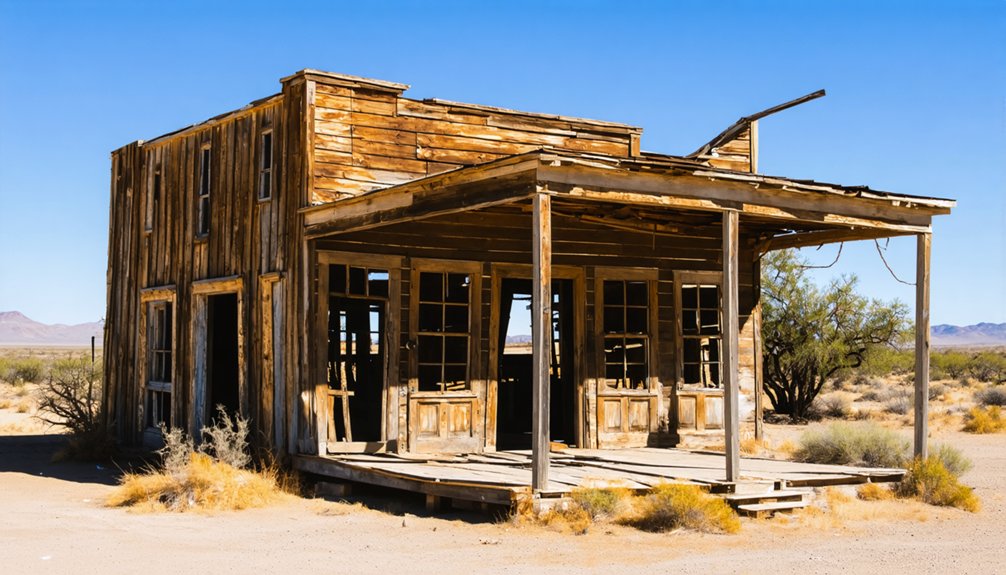You’ll find Gunsight, Texas nestled in north-central Texas, named for the distinctive V-shaped notch in nearby mountains resembling a rifle’s sight. This former frontier settlement transformed into an oil boomtown in the early 1900s, drawing prospectors and drilling crews during the region’s petroleum rush. Today, only six residents remain among abandoned structures and the old community center ruins, marking a stark shift from its bustling past. The town’s rich history of Native American conflicts, pioneer struggles, and oil wealth awaits discovery.
Key Takeaways
- Gunsight, Texas became a ghost town after its boom-and-bust cycle, declining from an oil boomtown to just six remaining residents today.
- The town was established in 1880 with a post office, named after the distinctive V-shaped notch in nearby Gunsight Mountains.
- Oil discoveries in the early 1900s transformed Gunsight into a bustling boomtown, attracting prospectors and drilling crews.
- The town’s strategic location along stagecoach routes became irrelevant with railroad development, contributing to its economic decline.
- Currently, Gunsight contains abandoned structures with no operational businesses or public facilities, preserving remnants of its frontier history.
The Story Behind the Name
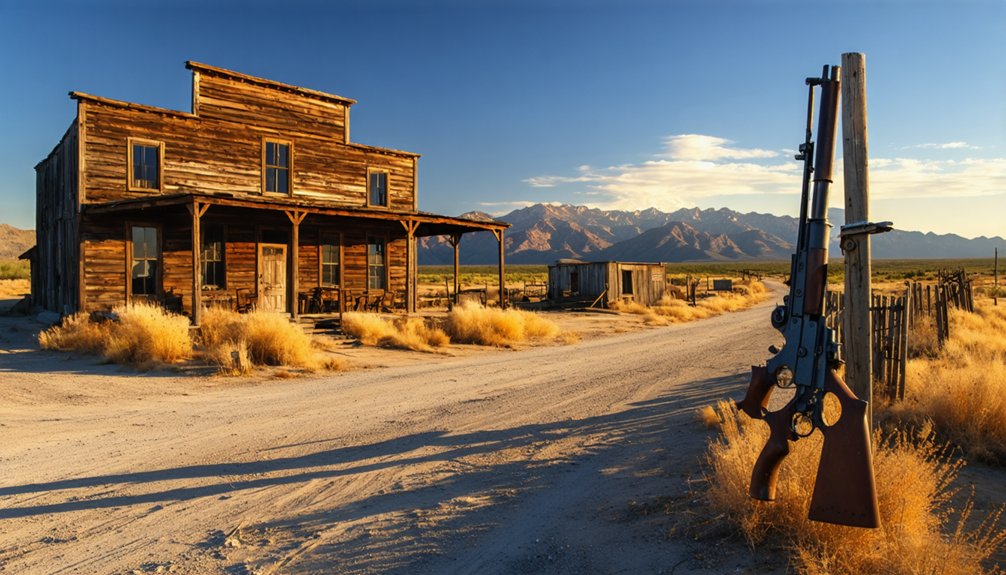
While many Texas towns derived their names from founders or prominent settlers, Gunsight earned its distinctive moniker from the nearby Gunsight Mountains, where a V-shaped notch in the range created a natural formation resembling a rifle’s sight.
Alternative name origins circulate through local legends, including tales of frequent shootouts and Native American conflicts.
You’ll hear stories of settlers repeatedly posting directional signs that were stolen, and claims that indigenous peoples called it “the site of many guns.”
Visitors today can witness the historical legacy at the community center ruins, where remnants tell tales of a once-thriving oil boom town.
However, the geographic connection remains the most credible explanation. The town’s strategic location along the wagon road from Fort Griffin to Stephenville made the mountain’s distinctive notch a natural landmark for travelers, cementing its place in Texas frontier history. The establishment of J. W. Maxwell’s store in 1880 marked the town’s first post office, serving as a vital hub for the growing community.
From Frontier Settlement to Oil Boom Town
You’ll find that Gunsight’s pioneer families faced the harsh realities of frontier life, including isolation, limited resources, and the constant challenge of establishing a viable community along the wagon road from Fort Griffin to Stephenville.
By 1880, the establishment of a post office under JW Shepard marked the town’s growing importance as a stagecoach exchange and frontier stop, serving local ranchers and travelers alike. Among the town’s earliest settlers were Smith D. Broyles and his family, who helped establish the growing community in 1868. The community thrived with two churches and gristmill, showcasing its development into a proper frontier settlement.
The early 20th century brought dramatic changes as regional oil discoveries transformed many Texas frontier towns, though Gunsight’s specific role in the oil boom remains less documented than its earlier frontier period.
Early Pioneer Life Hardships
From its founding in 1865, Gunsight’s pioneer families faced formidable challenges that tested their resilience and determination to build a new life on the Texas frontier.
You’ll find that these early settlers confronted daily survival challenges while establishing their homesteads along the old California Trail.
The most pressing pioneer challenges included:
- Constant threat of Comanche raids, forcing families to remain vigilant
- Limited resources and isolation, requiring self-sufficiency in food and supplies
- Harsh environmental conditions, from wolves threatening livestock to severe weather
These dangers were similar to those faced by the Goer family, who lost several members during a brutal Comanche attack in 1836.
Your ancestors’ survival strategies centered on community cooperation, as evidenced by collective cabin-building efforts led by settlers like Albert Wagley.
Living in basic log structures, these hardy pioneers supported one another while developing essential infrastructure around J.W. Shepard’s store and the stagecoach exchange point. Among the earliest settlers was James A. Notgrass, who arrived in 1876 and helped establish the growing frontier community.
Oil Discovery Transforms Town
During the early 1900s, Gunsight underwent a dramatic transformation as oil discoveries turned this quiet frontier settlement into a bustling boomtown.
You’d have witnessed prospectors, drilling crews, and speculators pouring into town, setting up temporary housing and makeshift businesses almost overnight.
The oil boom brought intense economic fluctuations as some struck it rich while others lost everything.
The Texas and Pacific Railway proved vital, helping transport heavy equipment and oil products that wagon teams had previously hauled.
Local merchants prospered as drilling companies like Transwestern Operating Co. developed multiple wells in the area’s Pennsylvanian formations.
While initial wells produced over 100 barrels daily, production typically settled around 20 barrels per day.
Like many oil towns of the era, Gunsight experienced dramatic price drops when overproduction flooded the market.
The rapid industrialization forever changed Gunsight’s character from a frontier outpost to an oil-driven community.
The town’s development mirrored the broader transformation happening across Texas, as the state shifted from a rural agricultural economy to an industrialized powerhouse.
Post-War Economic Decline
Before the transformative oil discoveries of the 1920s, Gunsight experienced a prolonged period of economic hardship and population decline. The settlement patterns shifted dramatically as the town’s strategic location along stagecoach routes became less relevant with the rise of railroad transportation elsewhere.
The economic challenges facing Gunsight’s residents were numerous:
- Limited agricultural potential due to rocky terrain and scarce water resources restricted farming and ranching expansion.
- Declining stagecoach and wagon traffic reduced demand for local services and supplies.
- Post-Civil War conditions slowed infrastructure development and deterred new settlers.
You’d have found a community struggling to maintain its frontier-era liveliness, with family ranches persisting but unable to generate significant growth. The preservation of Gunsight’s 500 years of history became increasingly important as the town faced potential abandonment. The town’s original focus on cotton farming and ranching proved insufficient to sustain long-term growth.
The population dwindled from its peak of 50 residents in 1890, leaving Gunsight increasingly isolated from regional commerce.
Life in Early Gunsight
While pioneer settlers faced numerous challenges in the Texas frontier, the establishment of Gunsight between 1865 and 1868 marked the beginning of a vibrant community along the wagon road connecting Fort Griffin and Stephenville.
Pioneer families like the Broyles built sturdy rock houses along Gunsolus Creek, establishing deep roots in the area. You’d find strong community bonds forming as the settlement grew from its initial 50 residents in 1880 to 150 by 1920.
Local marriages, like that of Rufus Broyles and Maggie Booher in 1904, strengthened these connections. The town’s strategic location as a stagecoach stop made it a hub for trade and transportation, while farming and ranching sustained the economy.
The establishment of a post office in 1880 and the local cemetery in 1877 reflected the community’s permanence.
Geographic Features and Natural Landscape
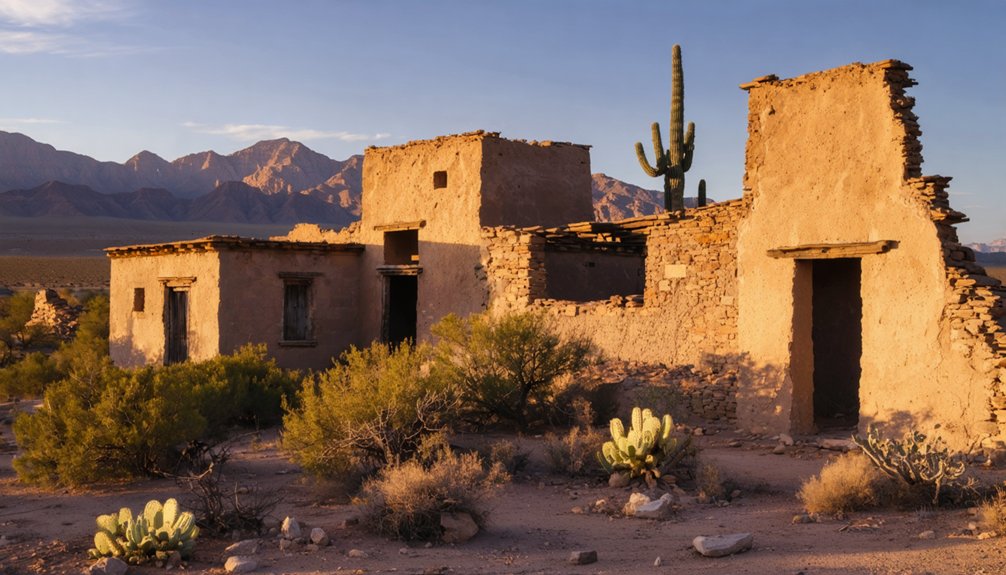
If you’re standing at Gunsight today, you’ll notice the town’s namesake mountains featuring their distinctive notch that early settlers likened to a rifle’s sighting mechanism.
The surrounding terrain presents a mix of elevated landforms and rugged outcrops typical of north-central Texas, creating a dramatic backdrop against the region’s semi-arid landscape.
The area’s natural features, which once supported both ranching and cotton farming, later proved valuable for oil production, transforming this frontier settlement into a briefly prosperous boomtown.
Mountain Range Distinctive Profile
The distinctive V-shaped notch in Gunsight Mountain stands as one of central Texas’s most recognizable natural landmarks, reaching 1,658 feet at its summit.
You’ll find this rugged terrain about 15 miles south of Breckenridge, where the mountain’s unique Gunsight silhouette dominates the landscape against a backdrop of rolling hills and mesas.
The range’s natural features create a striking visual impact through:
- Steep-sided rocky outcroppings carved by arroyos and erosion
- Dense coverage of native drought-resistant vegetation, from mesquite to wild rye
- Dramatic shadows and contours formed by draws and mesas
You’re witnessing a landscape that’s served as a natural marker since early settlement days, its profile visible for miles across the surrounding plains, embodying the untamed spirit of the Texas hill country.
Regional Terrain and Elevations
Standing at an elevation of approximately 4,000 feet, Gunsight Ranch emerges from a dramatic landscape where surrounding peaks in the Finlay Mountain Range soar beyond 6,000 feet.
You’ll find yourself surrounded by diverse terrain features that define this untamed corner of Texas, from rolling hills and steep-sided buttes to flat-topped mesas that pierce the horizon.
The rugged terrain creates natural shooting backstops throughout the property, while a network of arroyos and draws carves through the land, telling tales of water’s ancient path.
These elevation changes shape distinct micro-environments where native grasses, sagebrush, and hardy cacti thrive in the semi-arid climate.
As you traverse the landscape, you’ll discover how these geographical features have naturally divided the ranch into distinct zones, each offering unique opportunities for hunting, camping, or establishing an off-grid homestead.
Oil-Rich Desert Landscape
Beneath Gunsight’s rugged surface lies an expansive network of oil-rich geological formations, where sedimentary rock units and organic-rich shales stretch across the Permian Basin extension.
You’ll find a landscape shaped by deep-seated fractures and thrust faults that create natural traps for valuable hydrocarbons, making this area prime for oil exploration.
The arid terrain reveals:
- Broad basins and mesas rising to 5,100 feet, where sparse desert vegetation of mesquite and creosote bush dot the landscape
- Wind-sculpted dunes and exposed rock outcrops that showcase the region’s oil-bearing strata
- Dry river channels cutting through the Gunsight Canyons, revealing the complex geology that’s made this area economically significant
This harsh yet resource-rich environment continues to draw interest from those seeking to tap into its underground wealth.
Rise and Fall of a Texas Community
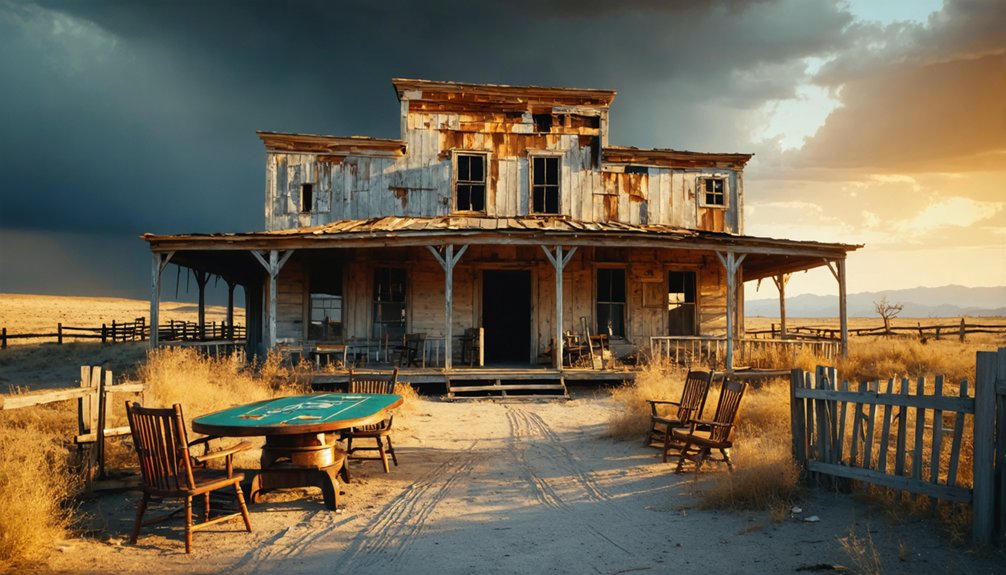
During the mid-19th century, Gunsight emerged as a frontier settlement along an essential wagon road connecting Fort Griffin to Stephenville. After the Civil War, settlers flocked to the area, drawn by land opportunities and the promise of a new start.
By 1872, you’d have found a bustling community demonstrating remarkable resilience through harsh living conditions and frontier challenges.
The town’s transient prosperity peaked during the oil boom after 1880, when the Texas and Pacific Railway reached nearby Eastland. You’d have seen a thriving downtown with a post office and active social life.
However, as the oil industry declined, so did Gunsight’s fortunes. The community’s population dwindled throughout the 20th century, transforming this once-promising settlement into one of Texas’s many ghost towns, marking the end of its frontier-era dreams.
What Remains Today
The weathered remnants of Gunsight tell a stark story of abandonment in modern-day Texas. If you venture into this near-ghost town today, you’ll find ghostly remnants of what was once a thriving community. Only six residents remain among the abandoned structures, with most buildings now roofless and deteriorating into the surrounding landscape.
The town’s current state reflects three stark realities:
- No operational businesses or public facilities exist, leaving the community without essential services.
- The once-vital post office, established in 1880, has long since closed its doors.
- Basic infrastructure continues to decline, with limited road maintenance and minimal utility services.
You’ll find Gunsight nestled in southern Stephens County, where the namesake mountains stand as silent witnesses to the town’s slow fade into history.
Historical Legacy and Local Folklore
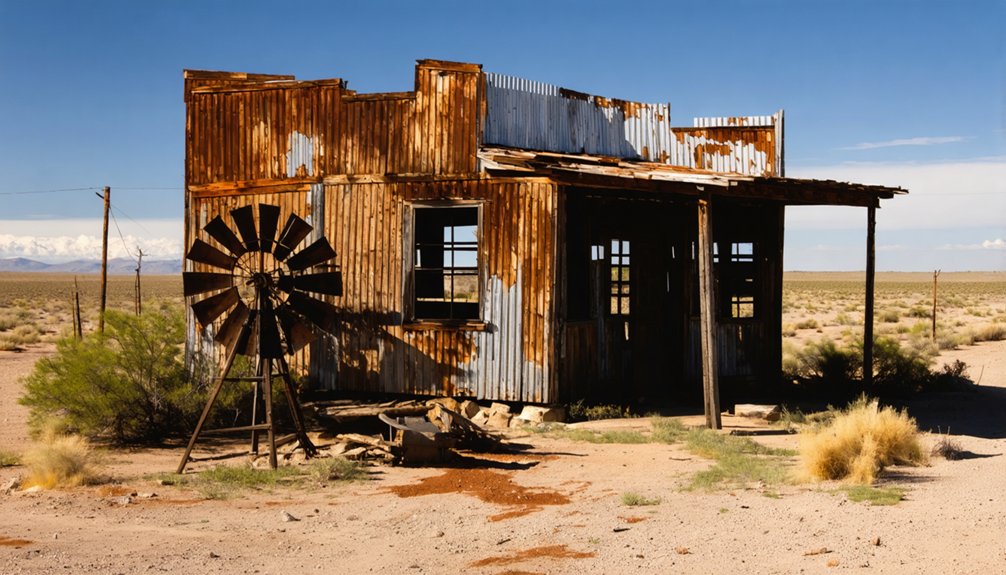
History flows through Gunsight’s weathered bones, telling a story far richer than its abandoned structures might suggest.
You’ll find cultural memory preserved in tales of Bret Maverick’s 1872 gambling loss to “the Kid” and the persistent theft of directional signs that marked the town’s location, hinting at a defiant local spirit.
The town’s folklore preservation extends beyond mere stories. In the cemetery, you’ll discover unique pioneer burial practices, with sandstone markers and pyramid-shaped rock piles that protected graves from wildlife.
The Methodist Episcopal Church, deeded in 1907, stands as evidence of the community’s resilience, while the Gunsight Mountains‘ distinctive notch continues to remind visitors of the untamed frontier that shaped this remarkable settlement’s identity.
Frequently Asked Questions
What Was the Population of Gunsight at Its Peak During the Oil Boom?
You won’t find exact peak numbers from the oil boom period, though population likely reached the thousands before experiencing dramatic decline, similar to comparable Texas towns that peaked around 1920.
Are There Any Surviving Photographs of Gunsight’s Original Buildings and Residents?
You won’t find any publicly documented historic photographs of the original buildings and residents today, though it’s possible some undiscovered images exist in private collections or local archives.
What Happened to the Oil Wells That Once Operated Near Gunsight?
You’ll find those oil wells from the 1920s boom have largely been abandoned, first after Southwestern Oil’s nitro accident, then gradually through the 1990s as production declined and maintenance costs exceeded profits.
Can Visitors Legally Explore the Remaining Structures in Gunsight Today?
Like walking through pages of history, you’re free to view exterior structures, but exploration regulations suggest getting local permission first. Visitor safety concerns mean entering buildings isn’t recommended.
Were There Any Notable Crimes or Lawmen Associated With Gunsight’s Frontier Period?
You won’t find documented gunfights or notorious outlaws specifically tied to Gunsight’s frontier period. While Texas had its share of lawlessness, historical records don’t reveal any major crimes or lawmen there.
References
- https://ceca.coop/sites/ceca/files/Forms/coma0508.pdf
- https://mavericktrails.com/gunsight.html
- https://www.hmdb.org/m.asp?m=155489
- https://www.ghosttowns.com/states/tx/gunsight.html
- https://en.wikipedia.org/wiki/List_of_ghost_towns_in_Texas
- https://www.texasescapes.com/TexasTowns/Gunsight-Texas.htm
- https://www.breckenridgeamerican.com/opinion/gunsight-established-stagecoach-exchange-1858
- https://www.tshaonline.org/handbook/entries/gunsight-tx
- https://www.breckenridgeamerican.com/opinion/cave-paintings-battle-creek-more-settlers-stephens-county
- https://www.youtube.com/watch?v=UnsFYTSZ7bU
